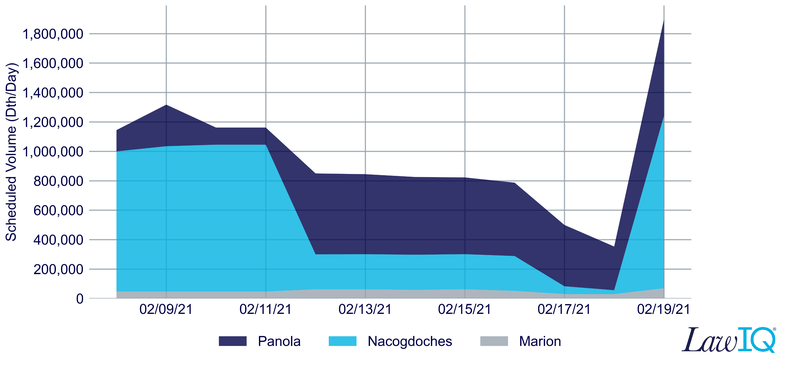What’s the issue?
Texas’s energy markets were roiled by an extended period of freezing weather that is not due to end until this coming week. Blame is being thrown around by all, but the root causes of the problem will probably not be known for months. Nonetheless, it is safe to say the failure can be tied to a lack of imagination that such an event could occur, which resulted in a decided lack of planning.
Why does it matter?
The weather impacted the electric grid most directly, but as a result, there have also been impacts to the supply of natural gas and the operations of the interstate pipeline system.
What’s our view?
Most of the impacts on the interstate pipeline system appear to have been driven by the lack of supply when the cold weather caused substantial reductions in natural gas production. The reduced supply of gas caused the state government to assert control over the “export” of gas beyond the boundaries of Texas. For now, those efforts have no apparent enforcement mechanism and we believe would be invalid if they were enforced. While FERC has announced a review of the performance by the grid operator, ERCOT, we assume it will eventually also look at how the interstate pipelines were impacted.
The Texas energy markets have been roiled since late last week when an outburst of freezing weather settled in for a nice long stay in the Lone Star State. A case study might focus on the state capital of Austin, where the high temperature on February 8 was 76 degrees and, since February 12, the high has not been above freezing, with that condition not expected to change until tomorrow. The pattern is very similar for Midland, the center of the Permian production basin, where the high was 77 degrees on the 8th, and has not been above freezing since February 11, and is only expected to move above that mark later today.
Texas’s situation has become a Rorschach test, where what you see is a reflection more of your own biases than reality. Some observers, including the governor of Texas, have sought to blame the LNG export terminals, wind power or out-of-state users of gas for the problems. Others have blamed the issues on an over-dependence on coal, nuclear and natural gas. While the root causes of the problem will probably not be known for months, the overarching issue will be a failure of imagination in that almost everyone simply failed to conceive of a weather event this severe, and neither the state government nor the energy industry apparently had plans in place to stop the cascade of events that have occurred.
The key question coming out of all the investigations, now that this type of weather pattern can be imagined, will likely be whether it is worth the added cost to prepare for such events or whether to assume the possibility of a recurrence is sufficiently unlikely to repeat itself and therefore do nothing in response. At least one politician seems to think it is not acceptable to take this risk going forward. U.S. Senator Ted Cruz of Texas, when California had rolling blackouts this summer, tweeted “California is now unable to perform even basic functions of civilization, like having reliable electricity.” In response to Texas’s own crisis, he simply tweeted the “man shrugging” emoji and the words “I got no defense. A blizzard strikes Texas & our state shuts down. Not good. Stay safe!”
While the failure to imagine this severe weather event impacted almost all aspects of the energy system in Texas, today we look at some key impacts on the interstate natural gas system. While FERC has announced a joint review of the performance of the bulk power system, which in Texas is managed by the Electric Reliability Council of Texas (ERCOT) -- which FERC does not even regulate -- we assume FERC will eventually also look at how the interstate pipelines it actually regulates were impacted. As we discuss below in detail, it is clear that the crisis arose from a multitude of converging issues, including the weather, which combined with the lack of electricity to create a deficit in the gas supply. How the industry will address each of these issues will be key to determining whether this problem repeats in the future.
Weather Impacts Both Equipment and Supply
It should come as no surprise to anyone that the equipment used in Texas, as compared to that used in colder regions of the country, is generally not designed to withstand sustained freezing temperatures. Natural Gas Pipeline Company of America (NGPL) issued a force majeure for its own equipment, a compressor station in Cameron Parish, Louisiana, due to the severe cold weather. But that situation was resolved in just about one day. The more significant complicating factor was the impact of the cold temperatures on the ability of the gas producers to keep production at normal levels.
A good example of this is NGPL, which issued a notice on February 5 requiring all shippers and operators system-wide, for both receipts and deliveries, to flow gas at the level of any confirmed nomination. NGPL said it would schedule down any supply points that were flowing less than the confirmed nomination to a quantity that reflects the physical flow. It then did this for a series of points in eastern Texas, as shown in the graphic below.

As seen above, the cumulative nominations at these receipt points in eastern Texas dropped from over 1 Bcf/day to just over 300,000 dth/day, but have recovered for today’s gas day to a level above those prior to the cold weather.
Other pipelines also noted that the cold weather was impacting the supply being put into their systems. On February 12, Colorado Interstate Gas noted that it was experiencing low line pack due to demands on the system coupled with supply shortfalls. It said these differences were adversely affecting its ability to maintain supply/demand balance along its entire system. Similarly, El Paso Natural Gas noted that it was seeing a substantial loss in supply from the Permian Basin as the result of cold winter temperatures and freeze-offs. It said its receipts into the system in the Permian Basin were approximately at 64% of scheduled quantities for Gas Day February 14, 2021.
The shortfall in receipts actually caused Northern Natural Gas to declare a force majeure event on February 15, which required it to physically curtail deliveries associated with the underperforming receipt points, but that condition was remedied within a day.
Government Response Beyond ERCOT
While much of the response to the crisis was focused on ERCOT, the Texas governor and the Texas Railroad Commission (TRRC) did direct some attention to the gas markets as well. On February 12, the TRRC issued a notice that revised a longstanding delivery priority for gas distribution companies, which moved electric generation used for human needs up to the second spot just below gas used directly for human needs. Also, the governor used his bully pulpit early in the week to suggest that the LNG terminals along the coast should stop using gas for liquefaction while there was such a desperate need for gas within the state. Facilities did pause liquefaction, but it was unclear whether it was as a result of the pressure or the adverse weather impacts on their own operations. Finally, late on Wednesday, the governor announced that he was exercising his emergency powers to require all gas sourced within Texas to “be made available for sale to local power generation opportunities before leaving the state of Texas.” He then sent this directive to the TRRC with a request that it immediately take all reasonable and necessary steps to ensure that this mandate is carried out.
In response to the governor’s mandate, the TRRC issued a “notice to operators” that notified them of the governor’s mandate but did not direct that they comply with the mandate or indicate how such a mandate would be implemented. We believe that any such attempt to enforce such a requirement would be unconstitutional because Congress, through the Natural Gas Act, has clearly asserted federal authority over the sale of natural gas in interstate and foreign commerce. We do not expect there to be any effort to enforce this notice by the TRRC.
With the weather easing over the coming weekend and into next week, we expect that the natural gas systems will quickly be restored to pre-blizzard operations. But ERCOT does not seem to be as optimistic about a quick restoration of normal operations for the electric grid. We will continue to follow the investigations that will be conducted to determine the root cause for all of these issues throughout the energy value chain, and we will report on any results that could impact the markets or companies we support.
We’ll be glad to dive deeper with customers on the impact of these events. Click here to schedule a meeting.


